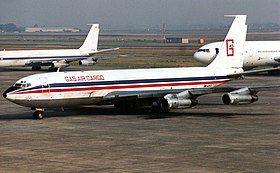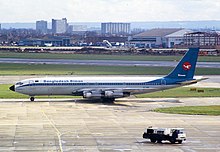Flight accident involving a Boeing 707 operated by GAS Air Cargo near Karm Umran
| Flight accident involving a Boeing 707 operated by GAS Air Cargo near Karm Umran | |
|---|---|
|
an identical Boeing 707-300C from GAS Air Cargo |
|
| Accident summary | |
| Accident type | Lack of fuel |
| place |
Karm Umran , Qina Governorate , Egypt |
| date | December 13, 1988 |
| Fatalities | 8th |
| Survivors | 0 |
| Fatalities on the ground | 1 |
| Aircraft | |
| Aircraft type |
|
| operator |
|
| Mark |
|
| Departure airport |
Dar es Salaam Airport , Tanzania |
| 1. Stopover |
|
| 2. Stopover |
Luxor Airport , Egypt |
| Destination airport |
Brussels-Zaventem Airport , Belgium |
| Passengers | 3 |
| crew | 5 |
| Lists of aviation accidents | |
The air accident of a Boeing 707 of the GAS Air Cargo at Karm Umran occurred on December 13, 1988 when a cargo plane of the type Boeing 707-351C of Nigerian GAS Air Nigeria (General Air Services) a cargo flight from the airport in Dar es Salaam in Tanzania to Cairo should be done in Egypt . The pilots then evaded to Luxor . The machine crashed on the way there. Nine people were killed in the accident.
plane
The aircraft used on the flight was a Boeing 707-351C. It was the 508th ever built Boeing 707 with serial number 19168th The machine had completed its first flight on July 1, 1966 before 12 July 1966, the air vehicle registration N367US to its first owner Northwest Airlines was delivered, where she Wore fleet identification number 367 . The machine was sold to Biman Bangladesh in December 1973 , which operated it as S2-ABN and gave it the name City of Shah Jalal . In June 1988 the machine finally went to the Nigerian cargo airline GAS Air Cargo, which approved the aircraft with the aircraft registration number 5N-AYJ . The four-engine long-range - narrow-body aircraft was equipped with four turbine jet engines of the type Pratt & Whitney Jt3d-3B equipped.
There was a five-person crew on board, consisting of the master, first officer, flight engineer, loadmaster and ground technician. In addition, three other people were on board as passengers.
Course of the flight and course of the accident
The flight of the machine had started in Dar es Salaam in Tanzania and should lead to Brussels-Zaventem Airport . A stopover for refueling was planned at Cairo International Airport . On arrival in Cairo the weather was very bad with visibility around 400 meters. After two missed approaches at 8:53 p.m. and 9:07 p.m., the crew decided to return to Luxor Airport, some 600 kilometers further south . However, the machine never arrived there. The plane crashed at 9:50 p.m. in a failed emergency landing in a residential area near Karm Umran on the Nile , around 45 kilometers north of Luxor. In addition to the eight people on board the machine, one person was also killed on the ground.
Cause of accident
According to the Egyptian accident investigators, the cause of the accident was a fuel shortage, which resulted from repeated missed approaches to Cairo, which continued until there was not enough fuel left to reach the alternative airport in Luxor.
The selection of an alternative airport that was too far away could also have played a role. In the Nile Delta there were various alternative airports that were closer to hand, for example in Alexandria . Even the air line from Cairo to Sharm el Sheikh or Hurghada is shorter than that to Luxor. However, on flights from Cairo to Luxor, the Nile River is available as a visual reference.
See also
swell
- Accident report B-707 5N-AYJ , Aviation Safety Network (English), accessed on October 21, 2019.
- Description of the incident on planecrashinfo.com
- Company history on rzjets
Coordinates: 26 ° 4 ′ 57.2 " N , 32 ° 48 ′ 11" E

